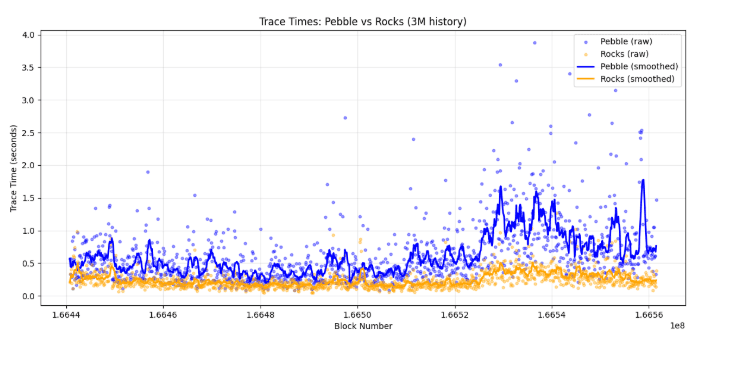RocksDB Backend Setup & Performance Guide
Overview
As Sei nodes accumulate more history and state data, iteration-heavy operations—like those performed during traceBlock calls—can become significantly slower. This is especially true for archive or RPC nodes where the state store contains millions of versions.
To address this, Sei supports RocksDB as an alternative backend to PebbleDB. RocksDB provides native multi-version concurrency control (MVCC) and column family support, which leads to substantial iteration performance improvements as history grows.
Why RocksDB?
PebbleDB lacks native MVCC support, meaning Sei must manually encode versions into keys. This retrofit approach causes iteration time to grow linearly with the amount of stored history. As a result:
- Archive nodes with large state stores experience slower debug trace latency.
- Each key lookup may require scanning multiple key versions.
- Iterations (e.g., over Oracle or EVM module keys) become increasingly expensive over time.
By contrast, RocksDB supports native user-defined timestamps and optimized column families for versioned data access. This means:
- Iterations over keys at a single version are much faster.
- Historical data growth has minimal effect on iteration cost.
- The performance advantage amplifies with larger node history.
In Sei’s benchmarks, RocksDB achieved up to 10–30× faster traceBlock iteration times compared to PebbleDB, with even greater benefits observed on archive nodes.
Example: TraceBlock Latency Comparison
The following chart compares iteration (trace time) performance between PebbleDB and RocksDB over a 3 million block history:

Trace Times: Pebble vs Rocks (3M history): RocksDB shows a significantly flatter latency curve as state grows, while PebbleDB’s iteration times increase sharply for older blocks.
Setup Instructions
RocksDB only needs to be built once. After that, you can install seid with RocksDB support directly.
Prerequisites
Ensure your system includes the following packages:
sudo apt-get update
sudo apt-get install -y build-essential pkg-config cmake git zlib1g-dev \
libbz2-dev libsnappy-dev liblz4-dev libzstd-dev libjemalloc-dev \
libgflags-dev liburing-devBuild & Install
Refer to the Sei Makefile here for the official targets.
# Step 1: Build RocksDB (one-time setup)
make build-rocksdb
# Step 2: Install seid with RocksDB backend
make install-rocksdbOnce installed, your seid binary will be built with RocksDB backend support:
seid version
# should include "rocksdbBackend" build tagConfiguration
After installation, update your configuration file to enable the RocksDB backend:
~/.sei/config/app.tomlSet
ss-backend = "rocksdb"Node Setup Notes
- RPC Nodes — must perform a state sync when spinning up a new node configured with RocksDB.
- Archive Nodes — currently, RocksDB is not supported for existing data unless syncing from genesis. A migration route from PebbleDB to RocksDB is being developed and will be shared soon.
Summary
| Feature | PebbleDB | RocksDB |
|---|---|---|
| MVCC Support | No | ✅ Native via user-defined timestamps |
| Column Families | No | ✅ Yes |
| Iteration Speed (Large State) | Slows with history | ✅ Up to 30× faster |
| Installation | Default | One-time build (make build-rocksdb) |
TL;DR
- RocksDB backend drastically improves trace iteration and historical query performance.
- Install once, then simply run:
make install-rocksdb- Update ~/.sei/config/app.toml to use RocksDB:
ss-backend = "rocksdb"- RPC nodes require state sync; archive nodes must currently sync from genesis
- Expect 10–30× faster trace latencies, especially on archive nodes or long-history setups.